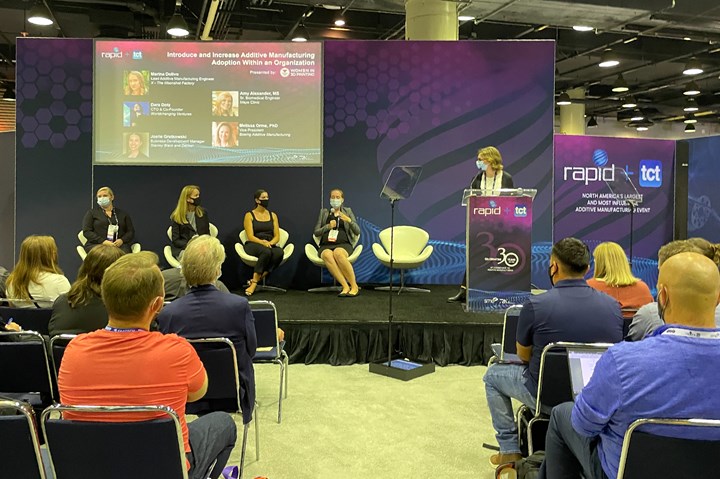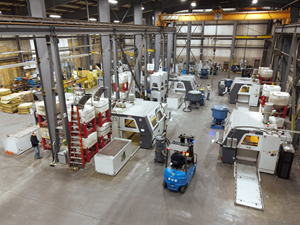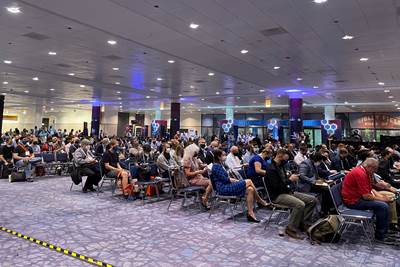8 Strategies to Drive Additive Manufacturing Adoption From Within an Organization
A panel discussion at RAPID + TCT 2021 brought valuable insights and ideas for advancing AM within large companies. The talk was organized by Women in 3D Printing.
For those who live and breathe additive manufacturing (AM), the benefits that this technology can bring are evident. But often, the people who know additive best are also the ones responsible for selling, promoting and advancing the technology within their organizations. It can be a frustrating position, to see the opportunities but be held back by the inertia of “the way it’s always been done.” How can this inertia be overcome? What are the best ways to bring colleagues, management and customers to see the opportunities that additive provides?
At RAPID + TCT 2021, a panel presentation hosted in the SME Zone Theater tackled this issue. The September 13 session was organized by Women in 3D Printing (personal note: I am the Cincinnati ambassador for the organization). The panel featured four women leading the AM charge in their companies: Amy Alexander, unit head, biomechanical development & applied computational engineering, The Mayo Clinic; Melissa Orme, VP of additive manufacturing, The Boeing Company; Joelle Gratkowski, business development manager, Stanley Black & Decker; and Marina Doliva, AM lead, X, the moonshot factory.
The panel was introduced by Wi3DP North American chair Haleyanne Freedman of M. Holland, and moderated by Olivia Krueger, quality engineer at Kohler Co.

Panelists from left to right: Amy Alexander, unit head, biomechanical development & applied computational engineering, The Mayo Clinic; Melissa Orme, VP of additive manufacturing, The Boeing Company; Joelle Gratkowski, business development manager, Stanley Black & Decker; and Marina Doliva, AM lead, X, the moonshot factory. Moderator, Olivia Krueger.
Here are eight of the strategies shared:
- Highlight existing successes. An example goes a long way toward illustrating the value of 3D printing. Doliva recommends regular lunch-and-learn sessions where AM experts within the company can share what they’ve accomplished with a wider group of their colleagues to show what is possible. Once employees know 3D printing is an option and who to go to, they will be more likely to seek out these team members when a potential opportunity arises.
- Get in early. “It’s hard to find business cases in your existing products,” Gratkowski says. By the time a product goes into production, the window of opportunity has already closed for additive manufacturing. 3D printing brings the most value when it is applied in very early stages. Orme talked about the value of embedding additive manufacturing engineers within product development teams to look for good AM candidates early in the process.
- Deputize AM experts. Gratkowski shared how at Black & Decker, there are a small number of “citizen developers” and “citizen designers” who are familiar with additive manufacturing, and empowered to evangelize the technology. An internal newsletter allows these individuals to share their successes with their colleagues, and helps these AM champions connect with each other.
- Prove that it works. Skepticism around 3D printing is difficult to overcome except with hard evidence. Gratkowski suggests providing colleagues with application examples as well as resources such as material data to help build confidence in the 3D printing process. Doliva also points to the value in conducting internal studies, such as producing the same part through conventional means and optimized through additive manufacturing to help illustrate the differences.
- Open up to customers. Using additive manufacturing is still primarily a “push” rather than “pull” proposition, Orme says, but putting 3D printing successes and capabilities in front of customers can help create demand. Alexander shared how this strategy has played out at the Mayo Clinic, where the engineering department supports surgeons by building the tools and models they need, often from back-of-napkin drawings. Once the surgeons become aware of the possibilities with 3D printing, “they will branch out” in their requests, she says.
- Look for pain points. “Engineers want to solve problems,” Gratkowski says. AM advocates can get a foothold by finding the opportunities within those problems — places where 3D printing can assist by speeding lead times, reducing weight or providing other benefits.
- Create a “petting zoo.” Doliva suggests keeping samples of past 3D printing successes on hand so that designers and engineers can interact with these items and look for inspiration while pursuing new applications for AM. Orme echoes the sentiment, suggesting that AM advocates maintain a “petting zoo” of 3D printed parts that colleagues and customers can touch and see to help illustrate the value.
- Apply only where necessary. While case studies and examples are valuable, Orme cautioned against diving headlong into 3D printing only for the sake of using 3D printing, or applying AM without also seeking assembly- or system-wide optimization. “Don’t give additive manufacturing a bad name,” she says. “Make sure it adds value. Use it for the things that can’t be made conventionally.”
For more insights and observations from RAPID + TCT 2021, view our slideshow; listen to a special episode of the AM Radio podcast; or watch our episode of The Cool Parts Show highlighting eight cool 3D printed parts found on the show floor.
Related Content
Additive Manufacturing Is Subtractive, Too: How CNC Machining Integrates With AM (Includes Video)
For Keselowski Advanced Manufacturing, succeeding with laser powder bed fusion as a production process means developing a machine shop that is responsive to, and moves at the pacing of, metal 3D printing.
Read MoreVulcanForms Is Forging a New Model for Large-Scale Production (and It's More Than 3D Printing)
The MIT spinout leverages proprietary high-power laser powder bed fusion alongside machining in the context of digitized, cost-effective and “maniacally focused” production.
Read MoreLooking to Secure the Supply Chain for Castings? Don't Overlook 3D Printed Sand Cores and Molds
Concerns about casting lead times and costs have many OEMs looking to 3D print parts directly in metal. But don’t overlook the advantages of 3D printed sand cores and molds applied for conventional metal casting, says Humtown leader.
Read MoreAt General Atomics, Do Unmanned Aerial Systems Reveal the Future of Aircraft Manufacturing?
The maker of the Predator and SkyGuardian remote aircraft can implement additive manufacturing more rapidly and widely than the makers of other types of planes. The role of 3D printing in current and future UAS components hints at how far AM can go to save cost and time in aircraft production and design.
Read MoreRead Next
Impressions and Trends from RAPID + TCT 2021: AM Radio Bonus
Peter Zelinski, Stephanie Hendrixson and Julia Hider discuss what they saw, heard and learned at RAPID + TCT 2021 in a special episode of the AM Radio podcast plus slideshow.
Read More8 Cool Parts From RAPID+TCT 2021: The Cool Parts Show #32
North America’s largest AM trade show resumed! Here are some of the coolest cool parts we found.
Read MoreHow to Implement Additive Manufacturing Across a Global Company: 5 Lessons
With more than 100 facilities and about 200,000 employees worldwide, Flex has a steep challenge in bringing 3D printing into its operations. Five things the company is learning.
Read More
.jpg;width=70;height=70;mode=crop)




















